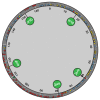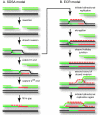Initiation of bacteriophage T4 DNA replication and replication fork dynamics: a review in the Virology Journal series on bacteriophage T4 and its relatives
- PMID: 21129203
- PMCID: PMC3016281
- DOI: 10.1186/1743-422X-7-358
Initiation of bacteriophage T4 DNA replication and replication fork dynamics: a review in the Virology Journal series on bacteriophage T4 and its relatives
Abstract
Bacteriophage T4 initiates DNA replication from specialized structures that form in its genome. Immediately after infection, RNA-DNA hybrids (R-loops) occur on (at least some) replication origins, with the annealed RNA serving as a primer for leading-strand synthesis in one direction. As the infection progresses, replication initiation becomes dependent on recombination proteins in a process called recombination-dependent replication (RDR). RDR occurs when the replication machinery is assembled onto D-loop recombination intermediates, and in this case, the invading 3' DNA end is used as a primer for leading strand synthesis. Over the last 15 years, these two modes of T4 DNA replication initiation have been studied in vivo using a variety of approaches, including replication of plasmids with segments of the T4 genome, analysis of replication intermediates by two-dimensional gel electrophoresis, and genomic approaches that measure DNA copy number as the infection progresses. In addition, biochemical approaches have reconstituted replication from origin R-loop structures and have clarified some detailed roles of both replication and recombination proteins in the process of RDR and related pathways. We will also discuss the parallels between T4 DNA replication modes and similar events in cellular and eukaryotic organelle DNA replication, and close with some current questions of interest concerning the mechanisms of replication, recombination and repair in phage T4.
Figures




References
-
- Barbour L, Xiao W. Regulation of alternative replication bypass pathways at stalled replication forks and its effects on genome stability: a yeast model. Mutation Research. 2003;532:137–155. - PubMed
Publication types
MeSH terms
Substances
LinkOut - more resources
Full Text Sources
Research Materials

